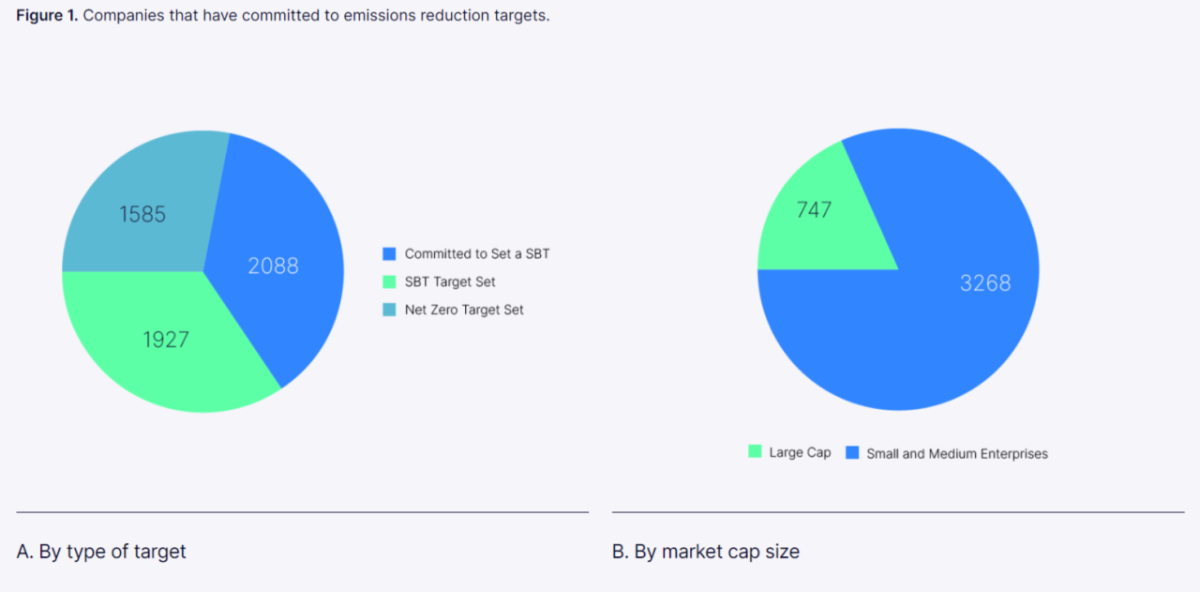Preparing for the Future: Building Climate Resilience for Your Business
By Ekaterina Hardin and Lia Brussock
What is Climate Resilience? Climate resilience is the ability to anticipate, prepare for, and withstand hazardous events, shifting consumer trends and behaviors, or business disturbances related to climate change.
Improving climate resilience involves (1) assessing how climate change will create new, or alter current, climate-related risks, and (2) taking steps to better cope with these risks.
Since 2020, the world has seen multiple major events - a global pandemic, a supply chain crisis, a geopolitical conflict and an overall economic volatility. These events have challenged businesses and their ability to remain resilient and to manage a range of external constraints.
- During the pandemic, labor shortages created clogged marine ports and made companies rely on air freight for logistics and transportation, increasing overall expenses and emissions. Corporates are looking for ways to cut their emissions that spiked during the supply chain crisis.
- The geopolitical crisis spiked energy and fuel costs. In absence of energy independence, the situation was worsened by the lowered production levels in the Middle East. Then recent diesel shortage added more fuel into the fire.
- The economic volatility felt by many in the most recent months made businesses look deep into their operations for ways to improve efficiency and cut expenses.
All these challenges are linked to transitional climate risks through fuel, energy and emissions. Setting climate impacts aside, not being able to access resources at low cost also has a direct financial impact. Being able to manage these risks in 2023 and beyond will help companies demonstrate climate resilience and provide access to capital in the long term.
Large Corporates Influence Their Supply Chain to Build Resilience
Climate resilience is crucial for all market participants up and down the value chain. To improve their transitional risk resilience, large corporations who have committed to net zero targets are now engaging with their critical suppliers. Large corporate clients are asking their suppliers to provide their GHG inventories, and in some cases, requiring them to set climate-related targets of their own. In this effort to pass down climate targets, these corporations are working to mitigate their own climate-related risks and improve climate resilience throughout their value chain. According to Nasdaq research, currently 58% of S&P 500 companies have a climate-related goal in their 2022 Proxy Statement. In addition, over 4000 companies of all sizes are taking action to reduce their emissions by setting science-based targets through the Science Based Targets Initiative. Almost half of the 4000+ have already set Science Based targets and almost 1500 companies have made Net Zero commitments (Figure 1A). Scope 3 emission targets (indirect value chain emissions) are a significant portion of these commitments.
Large cap companies are not the only ones committing to science-based emissions reduction targets. Small-to-Medium Enterprises (SMEs) make up almost 20 percent (18.6%) of the total companies listed by SBTi (Figure 1B). A total of 747 SMEs have set targets as of November 2022, in comparison to just 29 two years ago. GHG emissions reduction targets are emerging across market caps and organization types, and in many cases the influence of large corporations on their value chain is clear.
We at Nasdaq ESG Advisory hear about these cascade impacts from our clients: their large corporate customers expect them to measure and to reduce their own Scope 1 and Scope 2 footprints, otherwise they risk losing their shared business. This is a significant challenge that smaller and mid-size companies can anticipate in 2023 and beyond. The tide of climate action is rising, and smaller and mid-size companies now face challenges beyond responding to investor pressures and regulatory requirements. They must also address hindered ability to conduct business with large corporate customers. By not having a climate-related target in place, supply chain participants are exposing themselves to climate-related risks that will directly impact their financial health.
Global Transition to Low Carbon Economy and Geopolitical Crisis
Climate resilience has also been challenged this year by the global energy crisis. The 2022 energy crisis, associated with the geopolitical conflict in Ukraine, made energy costs soar. Consequently, high prices on crude oil and natural gas increased the cost of manufacturing and spiked transportation and distribution costs. Lower production levels in the middle east that followed fuel cost increase in the US, only made the situation worse. Additionally, most recently transition to low carbon economy has been under the microscope due to diesel shortages and associated surging diesel cost.
Back in 2020-2021, when marine transportation industry was clogged because of labor shortages, air freight was the only option to deliver goods to customers. Not only is air freight more carbon intensive, but it is also more costly. As a result, we saw increased emissions and narrower margins. Furthermore, in 2022 businesses that rely on fossil-based fuels for energy to produce and transport their goods saw additionally significant operational expense increases. The geopolitical crisis driving energy cost up, combined with a challenging economic environment emphasized the importance of climate resilience. While trying to stop the short-term value bleed, companies need to think about long-term resilience and build-in mitigation strategies such as self-generated energy and increased share of renewables and alternative fuels, so they can climb out of these challenging times ahead of their peers.
Current Economy and Climate Resilience
It is crucial for executives to set up their businesses for resilience in the long term, especially when markets are very volatile. In 2022, decreasing revenue growth rates and shrinking margins have been a focus for investors. Recession and inflation concerns have curbed investor appetite [Scenario Planning and Explaining Your Resilience – Nasdaq’s Advice on Appealing to Investors in Challenging Times]. To build trust with external stakeholders during these times, it is important for companies to explain their resilience to macro concerns like fuel shortage, energy, and raw materials cost. Additionally, understanding the industry trends and setting differentiators from peers will build confidence in management and will help companies to secure capital needed to navigate through the challenging times. Demonstrating financial resilience and climate risks resilience go hand in hand. Companies that are highly exposed to climate-related financial risks, such as energy cost and security, cost of raw materials, cost of transportation and logistics, can prove their financial resilience by demonstrating how they manage these climate-related risks.
Companies in varying sectors have different climate risk profiles, therefore, the way they demonstrate climate resilience would also be different. We encourage each company to access their business specific short-, mid- and long- term climate-related risks and put resilience strategies in place for those risks that companies cannot afford to tolerate in these downturn conditions. related risks and put resilience strategies in place for those risks that companies cannot afford to tolerate in these downturn conditions.
Understanding Your Business Resilience
In times of economic downturn and high volatility, demonstrating to stakeholders that you are an attractive investment, if revenues are down, is a challenge. Companies need to demonstrate how they are planning to capture future opportunities and curb financial risks in current economic conditions. Climate crisis often acts as a risk multiplier. It multiplies all financial risks - operational risk, credit risk, liquidity, underwriting. Being climate resilient company means being financially resilient company. It means capturing climate-related opportunities and mitigating climate-related financial risks better than your peers and competitors.
Knowing what risks your company is exposed to and how they can impact the financial condition and operations of your business across several time horizons and climate futures, will help executives put appropriate resilience strategies in place and build trust with investors.
Understanding industry risks and company specific resilience starts with understanding your risk exposure, risk vulnerability and your risk tolerance and how those might change in the future. For those risks that you cannot tolerate, management strategies must be put in place. At times when it is hard to justify R&D spend on new technologies, products, or services, optimizing efficiencies to reduce operational costs might be the best way to capture climate opportunities and demonstrate climate resilience. By conducting a peer assessment, understanding industry trends and how to achieve a competitive advantage at lowest cost possible, companies can make a business case for themselves and demonstrate to stakeholders that they are an attractive long-term investment.
The Challenges Nasdaq Sees & How We Can Help
Lack of climate expertise coupled with time and resources constraints are the most common pain points for corporates. Companies that are laser-focused on delivering business outcomes during challenging economic times need high efficiency and low-cost solutions. When time is money and when time needs to be spent on delivering products to the market, conducting labor- and time-intensive tasks such as peer benchmarking and assessment is a challenge for resource constrained companies. Staying on top of all the recent regulatory developments and tracking which direction political winds blow is also very time consuming and disrupting.
Climate risk is a systemic risk – meaning it is a risk you cannot diversify from. However, the way it impacts each industry and company varies. Each company’s path along the climate journey is unique. Businesses operate in different geographies, different sectors, have different supply chains and different stakeholders with different short- and long-term priorities. Nasdaq understands that each company has its own set of considerations, and we prepared to partner at each stage of their journey towards climate and financial resilience. Our goal at Nasdaq is to help our community build resilience and trust. We drive impact through cost-effective resources, tools, and guidance around climate data collection, risk identification, and disclosure, ultimately enabling our community to build competitive differentiation. To start your climate resilience journey, contact Nasdaq ESG Advisory here.
About the Authors
Ekaterina Hardin
Ekaterina Hardin is a Lead ESG Advisor focused on Climate at Nasdaq ESG Advisory Practice within our ESG Solutions Business. Ekaterina was previously with the Sustainability Accounting Standards Board (SASB) where she was the Extractives & Mineral Processing Sector Lead Analyst. Ekaterina was also SASB’s climate research lead and Net Zero working group owner. Prior to SASB, Ekaterina was an oil & gas geophysicist for over a decade with an M.S. in Geophysics from University of Moscow, Russia. Later in her career Ekaterina earned an M.S. in Environmental Engineering from UC Irvine, where she focused on Climate Change and Sustainability in the Energy sector.
Lia Brussock
Lia Brussock is a Senior ESG analyst within Nasdaq's ESG Advisory team. She joins the team with ESG, climate and corporate sustainability expertise. Her prior experience includes environmental footprint management at a global chemical and consumer goods company, where she led engagements with manufacturing facilities to advance progress towards global footprint targets. She is also well-versed in ESG strategy, reporting and benchmarking. Lia holds a M.S. in Sustainability Management from Columbia University and a B.A. in Global Environmental Change & Sustainability with a minor in Economics from Johns Hopkins University.



